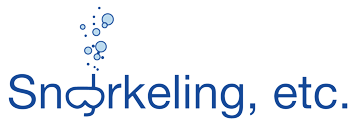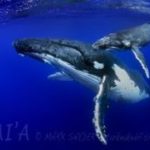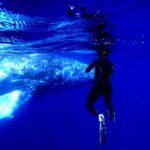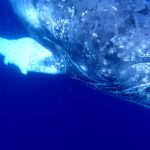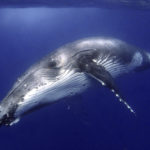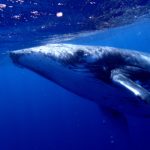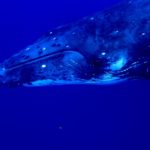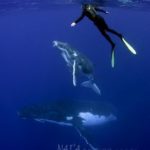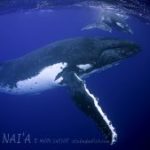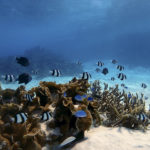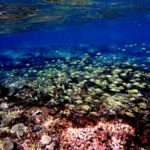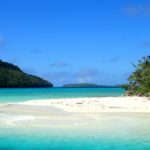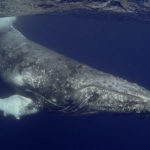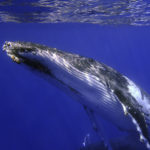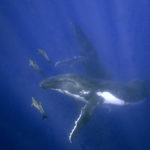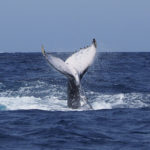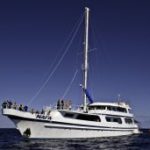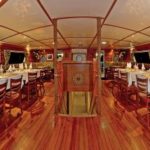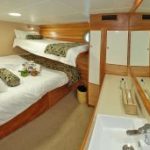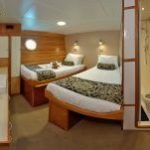
- This event has passed.
Swimming with Humpback Whales in Tonga! August 31-September 9, 2019
August 31, 2019 - September 9, 2019
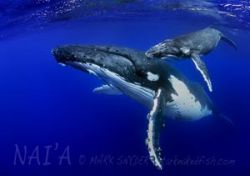
In July 2016 I traveled to Tonga to swim with Humpback Whales. I knew it would be interesting but I had no idea it would be so extraordinary and addicting! I knew I had to do it again and this time you can come with me!
I’m extremely excited to offer this unique and awesome adventure during peak Humpback Whale season in Tonga.
Humpback whales migrate from their feeding grounds in Antarctica to the Kingdom of Tonga, where they stay from July through September to court, mate and calve in Tonga’s (relatively) warm, tropical waters. Tonga is one of the few places in the world where one can swim close to these magnificent creatures.
Pregnant mothers arrive first in mid-July to give birth in warm, shallow water, which is easier and safer for newborn babies as it’s free from the main predators of baby whales, orcas and big sharks.
By the end of July the season is in full swing, with the maximum number of whales present throughout August.
During this part of the season, the whales are more relaxed, the calves are larger, more independent and curious. This is good news for us, as this can lead to remarkable interactions.
I traveled on the Nai’a with a group in Fiji in 2015. We all fell in love with the boat and the crew. It was an easy decision to return to their operation in Tonga, not only because it’s a class act but because of their reputation to be extremely respectful and sensitive towards the whales. Over the years the Nai’a guests snorkeled with humpbacks sometimes spending an hour or more on single encounters.
August 31. The Nai’a crew will transfer us to the boat starting at 2pm on Aug 31 from the airport or your hotel in Nuku’alofa town. Nai’a is schedule to depart at 2.30pm. As we settle into our comfortable cabins we begin the overnight 70 mile journey north into the untrammeled coral atoll wilderness of the Ha’apai island group, where the greatest number of humpback whale pods are found and NO other live-aboards.
August 31-Sep 9. Aboard the Nai’a.
Each morning following breakfast, the Nai’a will move from its protected overnight anchorage and begin the search for whales. Experience has proven the mornings to be the best time for whale spotting and swimming encounters.
Sailing throughout this maze of islands and reefs, the location and activity of the whales largely determines the precise course of each new day. Encounters with whales in the wild are slow, deliberate and as fascinating as they are exhilarating. It’s a mutual curiosity game. Whales are very intelligent and social. Often individuals will come close to check us out several times over, providing we are calm, patient and cohesive in the water.
It’s remarkable to be close to a Humpback and it’s truly an honor because the interaction is totally on the whale’s terms. Each time we swim with these creatures – lone whales, pairs, males, females – the whales call the shots. If the whales communicate through their movements that they are receptive then we can calmly slip in and hang out with them! We should have ample time to find, photograph and interact with the whales.
This is not your typical shallow coral reef snorkel trip. The primary focus of this trip is to swim with whales found at depths in the open ocean. Whale time maximus! That said, we will have opportunities to snorkel on coral reefs in the afternoons and also a chance for some villages visits and beach walks.
Evenings are at leisure to enjoy the sunset, enjoy a gourmet dinner and converse with your like-minded nature enthusiasts.
Sept. 9 Disembark at 8am on Sep 9 and transfer back to the airport and hotels within Nuku’alofa town. Fly onward to your home city or next destination.
What to Expect:
- This program is moderately strenuous. You must be physically fit, active and in good health.
- You must be able to swim unassisted in open water.
- August/September is considered to be the end of winter, which is a drier, cooler time of year.
Daytime Temperatures should be in the 70’s. - Water temperatures are cool-in the mid-70’s. A 3-5mil. wetsuit is recommended.
Price :
$6295.00 per person in a deluxe cabin based on double occupancy.
$5450.00 per person in cabin 9. Small cabin with single bunk beds.
This departure is sold out. Contact Wendy@SnorkelingEtc.com to be added to the waitlist.
The Nai’a.
The Naia is a gorgeous and solid expedition ship. Designed and built in Holland by the world’s finest steel yacht craftsmen, NAI’A is 120ft long and 30ft wide. Fijian hardwood grace the interiors. There is a dedicated camera room and a spacious top deck. The bow is a prime location for spotting whales and dolphins. The ample lounge/dining area is comfortable and the healthy and creative meals are some of the best I’ve had at sea. Any dietary request can be accommodated.
Nai’a accommodates 18 guests in nine spacious air-conditioned cabins, all with private bathrooms. All cabins have plenty of storage and both 110 and 220 volt power outlets. The Fijian crew is extremely capable and friendly. They generously share their knowledge, warmth, kava and music with their guests.
- The Nai’a
- Nai’a dining room
- Nai’a deluxe cabin
- Nai’a deluxe cabin
Trip includes:
- Scheduled round trip transfers from the airport or hotels in the Nuku’alofa area to the ship
- 9 nights onboard the Nai’a
- All meals aboard the ship
- Complimentary wine and beer served with dinner
- All whale watching and snorkeling activities from the Nai’a
Trip excludes:
- International Airfare
- Travel Insurance
- Fuel Surcharges. As of today there are no fuel surcharges. If this changes you’ll be notified 90 days in advance.
- Alcoholic beverages (other than house wine and beer served with dinner)
- Personal onboard purchases.
- Gratuities
Getting to Tonga:
Nai’a sails from Nuku’alofa, Tonga’s capital; airport code TBU. Most common flight routings are via Nadi, Fiji or Auckland, New Zealand. If there is a flight that allows you to arrive Nuku’alofa a day before the charter, that’s recommended. However there’s not a lot to do in Nuku’alofa so you don’t necessarily want more than one day.
Humpback Whale Facts & Figures
• Length from 40–52 ft (12–16 metres). Weight approximately 40 tons, females slightly heavier than males.
• Distinguished by: unique body shape, the bump in front of their small dorsal fin for which they are named, unusually long pectoral (side) fins, knobbly head and spectacular surface behavior, including dramatic breaching and competitive groups.
• Latin name, Megaptera novaeangliae, means “big winged New Englander” because humpbacks were originally described off New England and have the longest pectoral fin of any whale – which is the biggest single appendage in the animal kingdom, weighing up to three tons and measuring one third of the body length.
• Design of the pectoral fin helps to make long migrations. Leading edge covered in barnacles and tubercles: golf-ball-sized hair follicle lumps. Hydrodynamic experts calculated that these tubercles make the humpback whale swim 30% more efficiently. Others have calculated that just floating and bouncing up and down in waves, humpback pectoral fins may propel the whale forward at 3 knots while sleeping! They swim on average at five knots and can max out at ten knots.
• Life expectancy is estimated at least 40 to 50 years. Humpback whales are believed to mature between 5-10 years when they reach around 12m (40’) in length.
• Newborns (around 15 feet long!) are nursed by their mothers for one year, consuming up to 100 gallons (370 L) of chunky 50% fat milk per day.
• Hanging from their upper jaw is a series of baleen plates made up of a protein substance called keratin, like human hair and fingernails.
• Pattern on the fluke (underside of their tails) enables us to tell individuals apart.
• Small holes all over the whale are caused by parasitic cookiecutter sharks that use sharp teeth in their lower jaws to extract a chunk of flesh from their hosts.
• Dives last 10-15 mins, max 45 mins. Calves must surface to breathe every 1-5 mins.
• Blow: bushy, heart-shaped blast of mist about 15 ft (5 m) high is the result of air and water vapor launched at 900 mph (1400 kph). Don’t let this get on your camera or in your lungs.
• Whales breathe voluntarily and may shut off half of their brains when sleeping as do dolphins.
Humpback Whale Behavior
• Humpback whales are well known for active behavior, especially near or even above the surface: spy-hopping, tail-slapping and pec-slapping, peduncle throws, charging and chasing.
• Most dramatic and exciting is the breach during which the whale launches its entire body out of the water with just 2 to 3 flicks of the tail, making this muscle the strongest in the animal kingdom. Breaching could be a form of communication, warning, play or exercise to improve breath holding ability.
• Bull Runs (heat runs, rowdy groups): competitions between males for dominance. They race each other, ram and crash into each other. Sometimes you will see blood in the water and occasionally they get killed. This is a dangerous time to get in the water, but great to watch from the safety of this large, steel boat! We can follow them at 10 knots and they will not even notice us because they are so focused on their competition.
Whale Song
• Male humpbacks “sing” long and constantly evolving songs. Each song lasts 10-20 minutes, but could last for more than 24 hours.
• Cetaceans have no vocal cords, so whales generate their songs by forcing air through their massive nasal cavities.
• Purpose of the vocalizations not completely understood; it is believed to attract females or establish dominance over other males.
• The song across the South Pacific is the same at the beginning of the mating season but changes independently in each region as the season progresses, leading one researcher to speculate that the song is an oral history for the whales, synched in the feeding grounds and then modified for each different region during the mating season.
I look forward to hearing from you and hope you can join this remarkable and unique adventure!
Wendy@SnorkelingEtc.com
831-254-5001

Wendy Simon, C.T.C.
831-254-5001
Wendy@snorkelingetc.com
